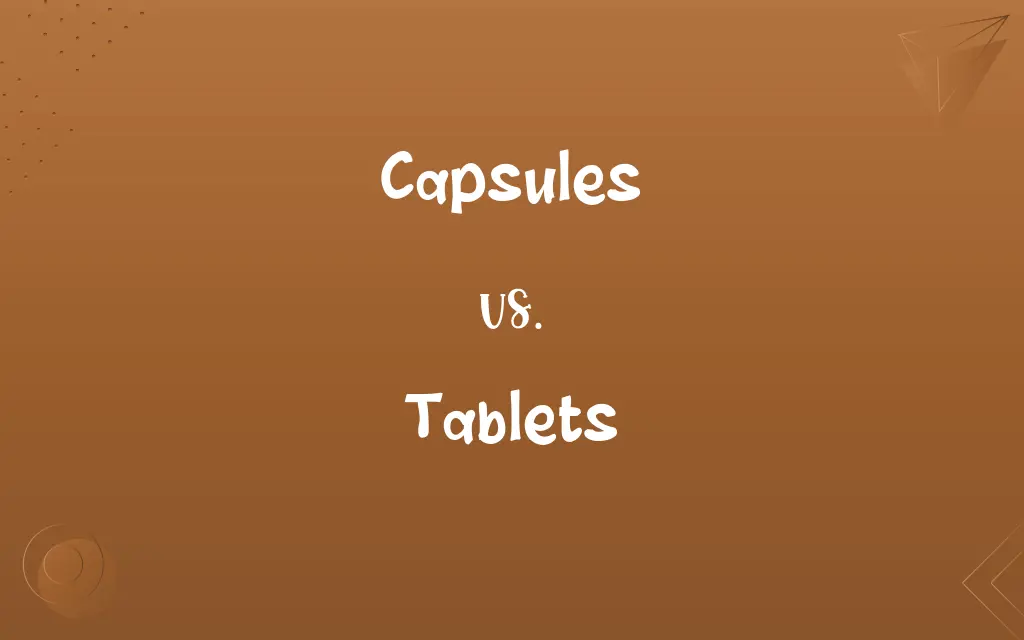Constructive Interference vs. Destructive Interference: What's the Difference?
Edited by Aimie Carlson || By Harlon Moss || Updated on October 11, 2023
Constructive interference occurs when waves combine to make a wave of larger amplitude, while destructive interference results in a wave of smaller or null amplitude. Both phenomena involve the superposition of waveforms.

Key Differences
Constructive interference and destructive interference pertain to the phenomenon of wave superposition, where two or more waves converge and the resultant wave is formed by combining the original waves. Constructive interference occurs when two waves meet in such a way that their crests line up together, and troughs line up together, essentially enhancing the overall effect of the wave. The resultant wave has a larger amplitude than the individual waves. This phenomenon might occur in any kind of wave, be it sound, light, or water waves, amplifying the effect or intensity of the resultant wave.
Conversely, destructive interference occurs when two waves meet in a manner where the crest of one wave aligns with the trough of another. In such an instance, the high point of one wave cancels out the low point of another, which can lead to a resultant wave having a smaller amplitude or possibly even becoming non-existent. This kind of interference is also omnipresent across different types of waves and can diminish or completely negate the effect or intensity of the resultant wave.
In practical applications, constructive interference can be witnessed in phenomena like the amplification of sound in resonance chambers, where sound waves enhance each other, creating a louder sound. On the other hand, destructive interference is utilized in noise-canceling headphones, where generated sound waves with amplitudes equal and opposite to the incoming noise result in a cancelation of the undesired sound. The applications underscore the constructive interference’s capacity to amplify and the destructive interference’s ability to diminish wave effects.
Moreover, constructive interference can be visibly observed in phenomena like Young’s Double Slit Experiment in light waves, where certain regions appear bright due to the constructive interference of light waves, enhancing light intensity. In the same context, destructive interference is observed as dark bands where the light intensity is minimized or nullified, providing a visible representation of the cancelling out of waves.
To succinctly summarize, constructive interference accumulates the energies of converging waves, resulting in a wave of greater amplitude, whereas destructive interference entails the cancelation out of waves, resulting in a wave of diminished or null amplitude. Both types of interference are fundamental in various applications across physics, engineering, and technology, manipulating wave phenomena for desired outcomes.
ADVERTISEMENT
Comparison Chart
Definition
Amplification of wave amplitude.
Diminution or nullification of wave amplitude.
Resultant Amplitude
Greater than the individual waves.
Smaller or null compared to the individual waves.
Alignment of Waves
Crests with crests, and troughs with troughs.
Crests with troughs, and troughs with crests.
Visual Representation
Bright or loud regions in light or sound waves respectively
Dark or silent regions in light or sound waves respectively.
Practical Applications
Enhancing signals and wave intensities.
Canceling out unwanted signals and wave intensities.
ADVERTISEMENT
Constructive Interference and Destructive Interference Definitions
Constructive Interference
The meeting and combining of waves to produce a resultant wave of heightened amplitude.
Through constructive interference, two converging light waves can produce a resultant wave that is visibly brighter.
Destructive Interference
A wave interaction that diminishes the resultant wave's impact due to opposite phase alignments.
Engineers employ destructive interference principles to design speaker systems that reduce unwanted frequencies.
Constructive Interference
The phenomenon where wave amplitudes add together, creating a larger resultant wave.
The concert hall was designed to promote constructive interference, optimizing sound distribution.
Destructive Interference
The interaction of waves in a way that they negate each other’s effects, reducing overall amplitude.
Destructive interference was observed in the ripple tank when wave peaks and troughs met, creating calm spots.
Constructive Interference
An interaction of waves where aligning crests and troughs intensify the resultant wave.
The scientist adjusted the experiment to study the effects of constructive interference on particle wavefunctions.
Destructive Interference
A phenomenon where colliding waves cancel each other out, reducing resultant wave intensity.
Acoustic engineers study destructive interference to design spaces that minimize echoes and reverberations.
Constructive Interference
A process wherein waves combine to generate a resultant wave with an augmented amplitude.
The architects utilized the principle of constructive interference to enhance sound clarity in the amphitheater.
Destructive Interference
An interference causing the resultant wave's amplitude to decrease due to misaligned crests and troughs.
Destructive interference in sound waves is utilized in noise-canceling headphones to mitigate unwanted noise.
Constructive Interference
A superposition of waves that enhances the amplitude and effect of the resultant wave.
Constructive interference in the lake, caused by aligned wave crests, occasionally results in unexpectedly large waves.
Destructive Interference
The superposition of waves leading to a diminished or null resultant wave amplitude.
In the double-slit experiment, dark bands on the screen illustrate areas of destructive interference in light waves.
FAQs
Is constructive interference always desirable?
Not always; the desirability of constructive interference depends on the application, like undesired signal amplification in communication systems.
In what scenarios is destructive interference beneficial?
Destructive interference is beneficial in noise cancellation, eliminating undesired sounds or waves.
How is destructive interference defined?
Destructive interference involves waves combining and canceling each other out, reducing the resultant wave's amplitude.
How does destructive interference affect sound waves?
It can cancel out sound waves, producing regions of reduced or absent sound.
Does constructive interference play a role in laser technology?
Yes, constructive interference is fundamental in amplifying light waves to generate coherent laser beams.
Is destructive interference relevant in optical technologies?
Yes, it's utilized in various optical technologies like anti-reflective coatings.
How can constructive interference be detrimental to wireless communications?
It can inadvertently amplify and distort signals, causing interference and miscommunication.
What is constructive interference?
Constructive interference occurs when waves combine, producing a resultant wave with increased amplitude.
Can constructive and destructive interference occur simultaneously?
Yes, in wave interactions, regions of constructive and destructive interference can occur concurrently.
Can constructive interference increase wave frequency?
No, constructive interference affects amplitude, not frequency.
How is constructive interference utilized in musical instruments?
It can enhance sound resonance, as observed in the body of string instruments like violins or guitars.
Can destructive interference be visually observed?
Yes, in phenomena like dark fringes in interference patterns from light waves.
How does destructive interference aid in stealth technology?
It can be used to cancel out waves, such as radar, reducing detectability in stealth technology.
How is constructive interference observed in light waves?
It is observed as bright bands or increased intensity where wave crests coincide.
Does destructive interference always completely cancel out waves?
Not necessarily; the degree of cancellation depends on the amplitude and phase of the interacting waves.
How does constructive interference relate to resonance?
Resonance involves constructive interference where waves reinforce each other, amplifying the resultant wave.
How is constructive interference relevant to broadcasting?
It can enhance signal strength in certain areas, improving communication and broadcasting quality.
Can destructive interference influence data transmission?
Yes, it can potentially disrupt or degrade signal quality during data transmission.
Can destructive interference be used to manage unwanted signals?
Yes, it's often utilized to nullify unwanted signals in various technological applications.
Are constructive and destructive interference only applicable to sound waves?
No, these phenomena apply to all wave types, including light, sound, and water waves.
About Author
Written by
Harlon MossHarlon is a seasoned quality moderator and accomplished content writer for Difference Wiki. An alumnus of the prestigious University of California, he earned his degree in Computer Science. Leveraging his academic background, Harlon brings a meticulous and informed perspective to his work, ensuring content accuracy and excellence.
Edited by
Aimie CarlsonAimie Carlson, holding a master's degree in English literature, is a fervent English language enthusiast. She lends her writing talents to Difference Wiki, a prominent website that specializes in comparisons, offering readers insightful analyses that both captivate and inform.






































































